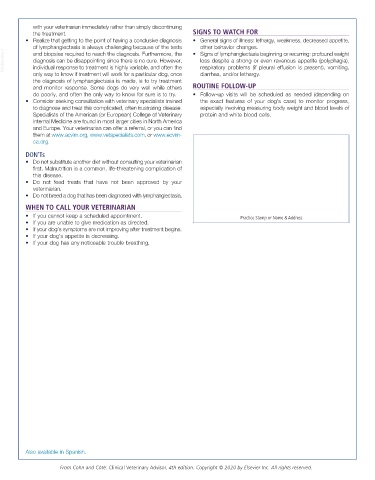Page 3063 - Cote clinical veterinary advisor dogs and cats 4th
P. 3063
with your veterinarian immediately rather than simply discontinuing
the treatment. SIGNS TO WATCH FOR
• Realize that getting to the point of having a conclusive diagnosis • General signs of illness: lethargy, weakness, decreased appetite,
of lymphangiectasia is always challenging because of the tests • Signs of lymphangiectasia beginning or recurring: profound weight
other behavior changes.
VetBooks.ir diagnosis can be disappointing since there is no cure. However, loss despite a strong or even ravenous appetite (polyphagia),
and biopsies required to reach the diagnosis. Furthermore, the
individual response to treatment is highly variable, and often the
respiratory problems (if pleural effusion is present), vomiting,
only way to know if treatment will work for a particular dog, once diarrhea, and/or lethargy.
the diagnosis of lymphangiectasia is made, is to try treatment
and monitor response. Some dogs do very well while others ROUTINE FOLLOW-UP
do poorly, and often the only way to know for sure is to try. • Follow-up visits will be scheduled as needed (depending on
• Consider seeking consultation with veterinary specialists trained the exact features of your dog’s case) to monitor progress,
to diagnose and treat this complicated, often frustrating disease. especially involving measuring body weight and blood levels of
Specialists of the American (or European) College of Veterinary protein and white blood cells.
Internal Medicine are found in most larger cities in North America
and Europe. Your veterinarian can offer a referral, or you can find
them at www.acvim.org, www.vetspecialists.com, or www.ecvim-
ca.org.
DON’Ts
• Do not substitute another diet without consulting your veterinarian
first. Malnutrition is a common, life-threatening complication of
this disease.
• Do not feed treats that have not been approved by your
veterinarian.
• Do not breed a dog that has been diagnosed with lymphangiectasia.
WHEN TO CALL YOUR VETERINARIAN
• If you cannot keep a scheduled appointment. Practice Stamp or Name & Address
• If you are unable to give medication as directed.
• If your dog’s symptoms are not improving after treatment begins.
• If your dog’s appetite is decreasing.
• If your dog has any noticeable trouble breathing.
Also available in Spanish.
From Cohn and Côté: Clinical Veterinary Advisor, 4th edition. Copyright © 2020 by Elsevier Inc. All rights reserved.

